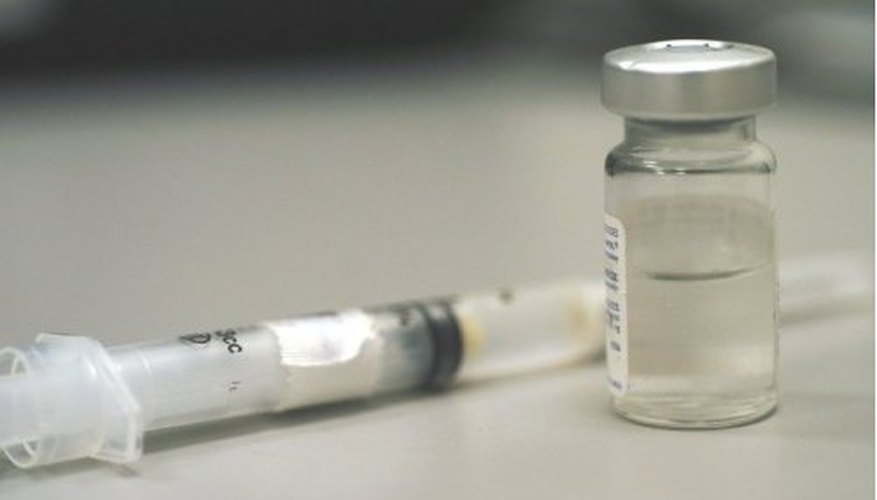Euthanasia gets its name from the Greek words for good death--a death that means a minimum of suffering or distress for the animal. Veterinarians have many drugs to choose from when it is necessary to put an animal to sleep.Your vet also may use a sedative to calm the animal before a euthanizing agent is used, but sedatives can affect circulation and delay the effects of these agents.
Choosing Agents
Veterinarians choose the methods used for euthanasia based on meeting a number of vital criteria, including the time it takes to create loss of consciousness, how reliable the method is and the effect the method has on observers.
- Veterinarians choose the methods used for euthanasia based on meeting a number of vital criteria, including the time it takes to create loss of consciousness, how reliable the method is and the effect the method has on observers.
Methods must be appropriate for the species of animal, its age and the need to examine the tissues afterward. The chosen method must not be reversible and must also protect the personnel involved.
Euthanizing agents may bring about death by disrupting brain activity, deprivation of oxygen or depressing neurons that bring control necessary life functions. Loss of consciousness comes before loss of muscle control to provide a painless procedure.
Barbiturates
Barbiturates are fast-acting, inexpensive and cause minimal discomfort for animals, but they require trained personnel to inject them intravenously, and the animals receiving such an injection must be restrained. They can be used in dogs, cats, small animals and horses.
Pentobarbital causes unconsciousness and cardiac arrest. The death appears quiet and peaceful. Pentobarbital may be combined with chloral hydrate for large animals. It depresses the area of the brain controlling breathing.
- Barbiturates are fast-acting, inexpensive and cause minimal discomfort for animals, but they require trained personnel to inject them intravenously, and the animals receiving such an injection must be restrained.
- Pentobarbital may be combined with chloral hydrate for large animals.
The drug may be given via three routes--intravenous, intracardiac (to be used only on unconscious or deeply sedated animals) or intraperitoneal (takes up to 15 minutes to work in a cat or dog).
T-61 combines three euthanasia drugs. Tricaine methane sulfonate is suitable for use on amphibians and fish.
Inhaled Anesthetic
There are a large number of inhaled agents, but few are preferred for use. Ether works slowly, is an irritant and is flammable. Methoxyflurane acts slowly and may cause agitation, but is acceptable for rodents.
- There are a large number of inhaled agents, but few are preferred for use.
- Methoxyflurane acts slowly and may cause agitation, but is acceptable for rodents.
Isoflurane has a pungent odour. Animals may resist breathing it and may need more of the drug (than halothane). Desflurane is the least soluble form and most pungent, which may slow inducement of unconsciousness.
Halothane is the preferred choice and acts as a rapid anesthetic. Enflurane is as effective as halothane, but it may cause seizures. Sevoflurane is less potent than halothane.
Small animals may be placed in a gas chamber. Carbon monoxide can be used after the animal is unconscious. Carbon dioxide, nitrogen and argon are also sometimes used. Nitrous oxide can be used along with other inhalants but does not work alone. Finally, general anaesthesia may be used along with potassium chloride, as it is more easily obtained and less toxic in the animal's remains.
Some of these agents, including nitrous, may be abused by humans and some can cause severe side effects in humans who become exposed, making their use potentially more problematic.
Large Animals
Large animals may require catheterisation due to the amount of barbiturate needed to euthanize. For large animals, a vet may choose Suomulose (Secobarbital and Cinchocaine) or Tributame (Embutramide, Chloroquine, Lidocaine) because they constitute less volume for injection. They supposedly act faster because of this. The drugs cause unconsciousness and cardiac arrest separately.
- Large animals may require catheterisation due to the amount of barbiturate needed to euthanize.
- For large animals, a vet may choose Suomulose (Secobarbital and Cinchocaine) or Tributame (Embutramide, Chloroquine, Lidocaine) because they constitute less volume for injection.
Reasons
Euthanasia may be utilised in a number of situations, for both healthy and terminally ill pets. It is used as a humane death for animals who may suffer in their final days, aged animals or those in the late stages of an illness. It is used to eliminate dangerously diseased animals (such as those who have rabies) and animals with dangerously aggressive behaviour.
- Euthanasia may be utilised in a number of situations, for both healthy and terminally ill pets.
- It is used as a humane death for animals who may suffer in their final days, aged animals or those in the late stages of an illness.
More controversial uses include putting an animal down because of lack of space in a home or shelter, lack of homes available for pet adoption, and injury or illness that could be treated but is beyond the financial means of the pet's owner.
